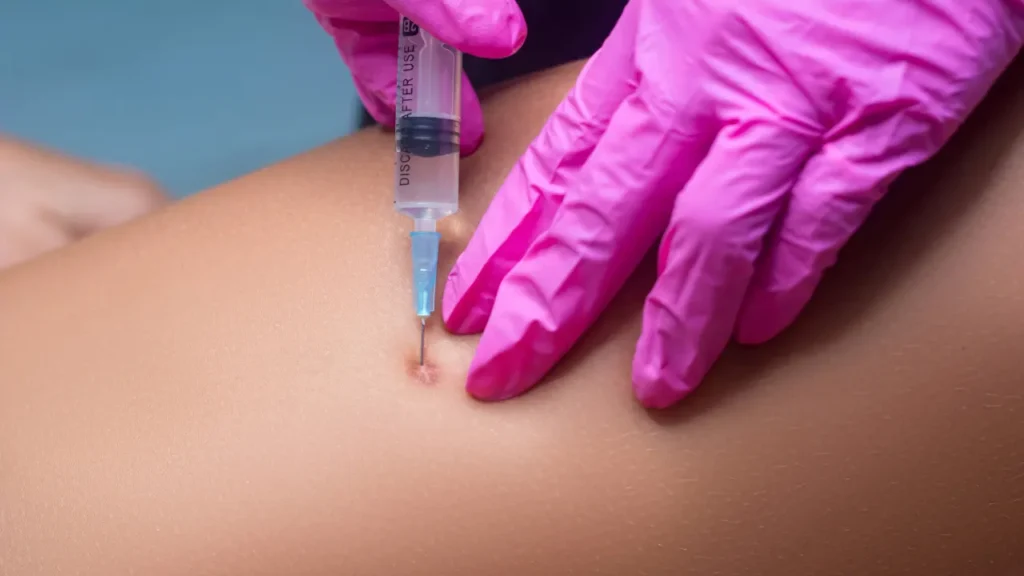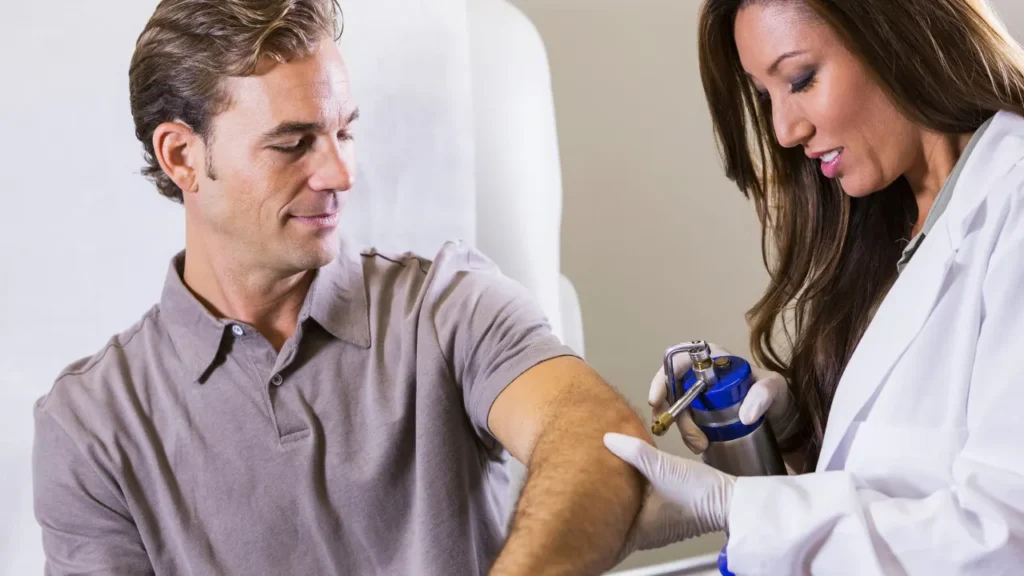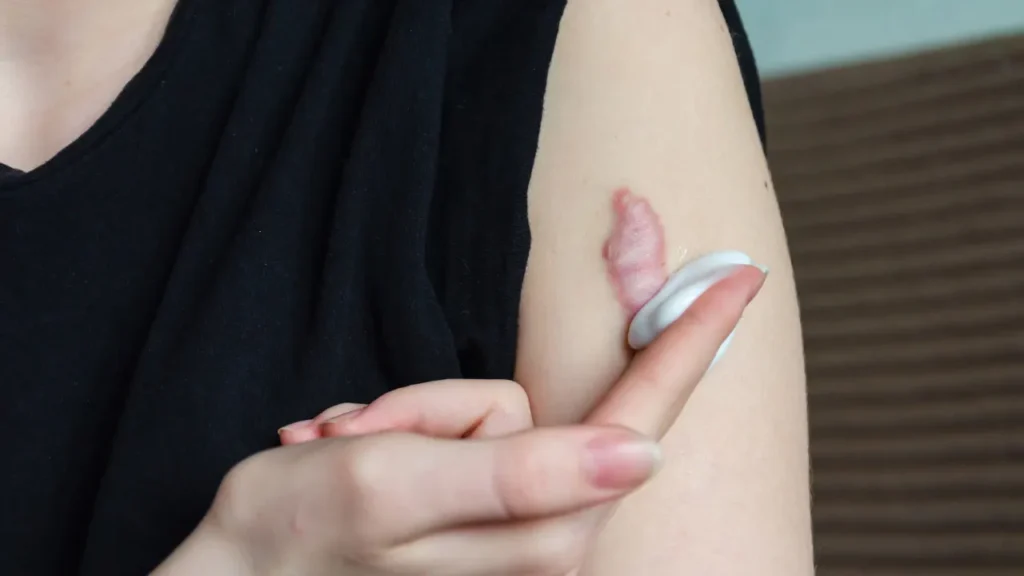Description
Keloid scars are an irregular kind of scar tissue growth that spreads past the initial limits of an injury or lesion. The excessive development of keloid scars exceeding the confines of the initial lesion distinguishes them from normal scars. They frequently take the form of smooth, shiny, elevated growths that occasionally have colors that are distinct from the skin that surrounds them. These scars can itch, be uncomfortable, or even hurt. The chest, shoulders, earlobes, and upper back are common places where keloids appear.
You May Also Like:
NATUREMYST KRILL OIL: A REVIEW OF THE FACTS ABOUT THIS LEADING OMEGA-3 PRODUCT
MEMBER’S MARK EXTRA STRENGTH OMEGA-3 KRILL OIL REVIEWED: A LEADING JOINT HEALTH PRODUCT
Keloid scars: Description, Causes, And Treatment Protocol is an original (HealthXWire) article.
Possible Causes
It is unclear what triggers keloid scar formation exactly. However, many factors, such as genetic susceptibility, improper wound healing procedures, increased collagen formation, and inflammation, play a role in their development. Additionally, keloid formation has been linked to trauma, burns, acne, surgery, and other skin disorders.
Exacerbating and Mitigating Factors:
Trauma or Injury: Skin damage or injury frequently results in keloid scarring. Keloid formation can be triggered by minor cuts, acne, burns, body piercings, immunizations, and even surgical incisions.
The Strain on the Wound: Keloid scar formation can be influenced by excessive stress on the recovering wound. Keloids are more likely to form on body parts that experience a lot of tension, like the shoulders or chest.
Infection: The likelihood of developing keloid scars is increased by having an infected wound. Infection-related inflammation can impede normal wound healing and promote overgrowth of scar tissue.
Ethnicity: Comparatively, to other populations, some ethnic groups, like people of Asian, African, or Hispanic heritage, have a higher propensity for keloid scarring. This implies that keloid development has a hereditary component.
Genetic Predisposition: A higher risk of keloid scar development exists in those with keloid scarring history in their family. The body’s reaction to healing wounds and the development of excess scar tissue can be influenced by genetic factors.
Mitigating Factors:
Early Intervention: Keloid scar development risk can be reduced by rapidly treating wounds and getting medical assistance for any indications of infection or sluggish healing. Early management can promote proper wound healing and lower the risk of extensive scar tissue formation from appearing.
Keeping the Wound from Tension: As the lesion heals, releasing tension can help prevent the development of keloid scars. It is also useful to apply methods like minimally tensing the suture line or tension-relieving tools.
Proper Wound Care: The formation of keloid scars can be reduced by using proper wound care techniques. This involves keeping the wound clean, refraining from picking or scratching the scab, and using the proper ointments or dressings as directed by a healthcare provider.
Pressure Therapy: Scar tissue can be flattened and softened by applying pressure on the healing wounds or keloid scars by using specific dressings, clothing, or silicone sheets. After surgery or an injury, pressure therapy is frequently advised as a preventative step if you are are prone to keloids.
Steroid Injections: By flattening the scar and reducing inflammation, corticosteroid injections given by a medical practitioner can help treat keloid scar symptoms. If you are vulnerable, starting steroid injections early might help your body to avoid keloid formation or minimize scar size.

Standard Treatment Protocol
A multidisciplinary approach is used in the management of keloid scars while taking into account each patient’s unique situation and the following scar features:
Surgical Removal: The keloid tissue that causes scarring are removed during surgical excision. However, there is a chance of recurrence, and the operation can leave behind fresh keloid scars. Aside from surgery, other therapies including radiation therapy or corticosteroid injections can be used to reduce recurrence.
Radiation Therapy: In addition to surgical excision of keloid scars, radiation therapy can be used . To lower the possibility of a recurrence, a minimal radiation dose is applied to the surgical site. Radiation therapy is typically used in specialized medical facilities for bigger or recurrent keloids.
Cryotherapy: Liquid nitrogen is used in cryotherapy to deliver extremely low temperatures on the keloid scar. The scar can flatten and shrink as a result of cell death brought on by freezing. Both alone and in conjunction with other treatments, cryotherapy is a good option.
Corticosteroid Injections: An effective treatment for keloid scars is intralesional corticosteroid injections. Triamcinolone acetonide is a type of corticosteroid that can be injected directly into keloid scars to flatten them, reduce inflammation, and soften scar tissue.
Pressure Therapy: Pressure is given on the keloid scar during pressure therapy by using silicone sheets, specialized clothing, or dressings. Over time, the persistent pressure aids in flattening and softening the scar tissue. The effects of pressure therapy usually appear gradually over a period of several months.
Sheeting or Silicone Gel: A non-invasive therapy alternative for keloid scars includes sheeting or silicone gel. These items moisturize the skin, form a barrier of protection around the scar, and offer light compression. Silicone enhances the texture and look of the scar while reducing redness, itching, and irritation.


Treatment Options
There are many different methods for treating keloid scars, all of which aim to lessen the signs and symptoms of the scars. Depending on the degree and features of the keloid scar, these methods can be used singly or in combination. The following are some typical keloid scar treatments:
Prescription Medications:
- Corticosteroids
Topical corticosteroids can also be used along with injections to treat keloid scar symptoms and inflammation.
- Imiquimod
Imiquimod is an immunomodulator that can be applied topically to boost the body’s defenses and shrink keloid growth.
- 5-Fluorouracil
This treatment, which can be given topically or by injection into the keloid, prevents the formation of aberrant cells.
Over-the-Counter Formulations: These include:
- Topical Creams
Several over-the-counter lotions have components including vitamin C, vitamin E, and onion extract which are substances that can help heal keloid scars.
- Sheeting or Silicone Gel
To lessen the look of keloid scars, there are solutions like sheeting or silicone gel that can be purchased over-the-counter.


Nutritional Supplements: Dietary supplements can help promote wound healing and reduce the visibility of keloid scars. Some supplements in a whole treatment strategy may be advantageous, but they shouldn’t be used in place of recommended medical therapies. Some nutritional supplements include the following:
- Vitamin C
Collagen is necessary for the creation of scar tissue and is synthesized only when vitamin C is present. Additionally, it functions as an antioxidant to defend against cell deterioration. Citrus fruit, bell peppers, strawberries, and broccoli are a few examples of foods high in vitamin C.
- Vitamin E
Antioxidant vitamin E can help scars heal and promote healthy skin. It can be found in a variety of foods, such as leafy green vegetables, nuts, seeds, and vegetable oils. Nevertheless, it is significant to observe that high-dosage supplements of vitamin E are not advised as they can affect blood clotting.
- Zinc
Numerous cellular functions involving zinc include collagen synthesis, immune system operation, and wound healing. For the proper development of scars, sufficient zinc levels are crucial. Seafood, meat, legumes, seeds, and nuts are all good sources of zinc.
- Omega-3 Fatty Acids
Omega-3 fatty acids, which are also present in flaxseeds, chia seeds, walnuts, and fatty fish like salmon and mackerel, contain anti-inflammatory properties and can help lessen inflammation linked to keloid scars. Supplements including flaxseed oil or fish oil are another way to get these good fats into your diet.
- Collagen Peptides
Since collagen is the primary structural protein within the skin, taking collagen peptide supplements can aid in tissue healing and lessen the visibility of scars. You must choose renowned companies when buying collagen peptides, which are available in capsule or powder form.
- Bromelain
Pineapple contains an enzyme called bromelain which possesses anti-inflammatory properties. When consumed as a supplement, it can help lessen the inflammation linked to keloid scars.
Natural and Herbal Remedies: The visible appearance of scars caused by keloid can be improved by using natural and herbal treatments, that are used traditionally to encourage wound healing. These herbal and natural treatments for keloid scars include the following:
- Aloe Vera Gel
Aloe vera contains calming and wound-healing properties. Aloe vera gel used on a keloid scar might help in minimizing inflammation and encourage healing.
- Honey
Honey has long been used for its ability to heal wounds. Inflammation and healing can be aided by putting medical-grade honey on keloid scars.
- Tea Tree Oil
Anti-inflammatory and antimicrobial properties are present in tea tree oil. You can topically administer diluted tea tree oil on the keloid scar.
- Gotu Kola
A traditional remedy for promoting wound healing uses the Asian plant gotu kola. Applying it topically or ingesting it as a supplement can assist in reducing the visibility of keloid scars.


Conclusion
It is significant to keep in mind that the efficacy of various treatment approaches can differ from person to person. As a result, speaking with a dermatologist or other healthcare provider is advised to ascertain the best course of action for your particular situation.
Additional resources for further reference
https://www.aad.org/public/diseases/a-z/keloids-treatment
https://www.healthline.com/health/keloids
https://familydoctor.org/condition/keloids/
Important Note: The information contained in this article is for general informational purposes only, and should not be construed as health or medical advice, nor is it intended to diagnose, prevent, treat, or cure any disease or health condition. Before embarking on any diet, fitness regimen, or program of nutritional supplementation, it is advisable to consult your healthcare professional in order to determine its safety and probable efficacy in terms of your individual state of health.
Regarding Nutritional Supplements Or Other Non-Prescription Health Products: If any nutritional supplements or other non-prescription health products are mentioned in the foregoing article, any claims or statements made about them have not been evaluated by the U.S. Food and Drug Administration, and such nutritional supplements or other health products are not intended to diagnose, treat, cure, or prevent any disease.
Table of Contents


